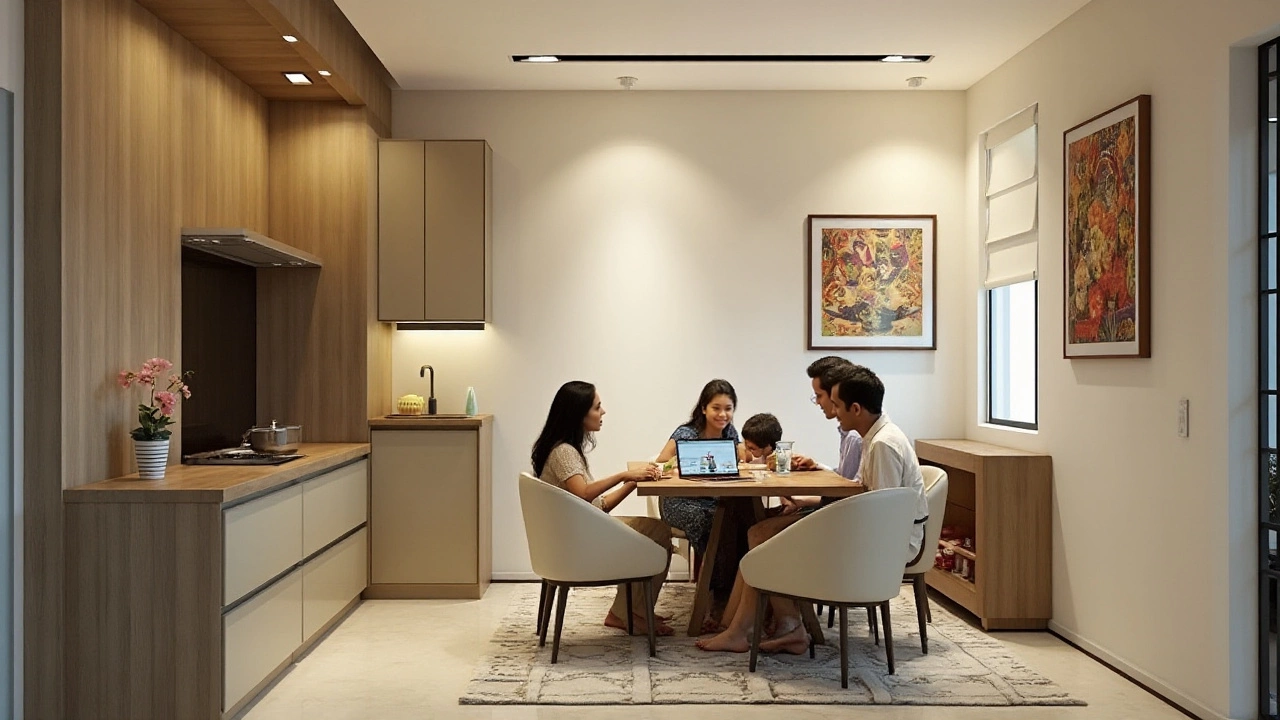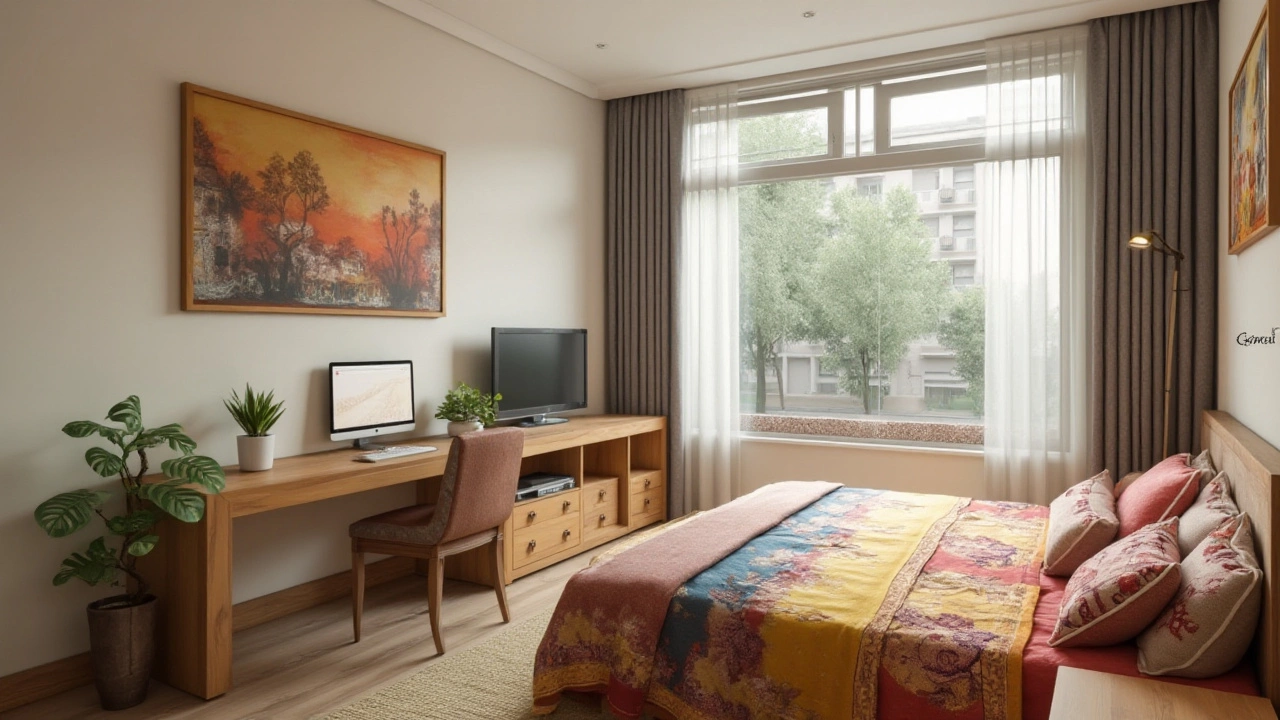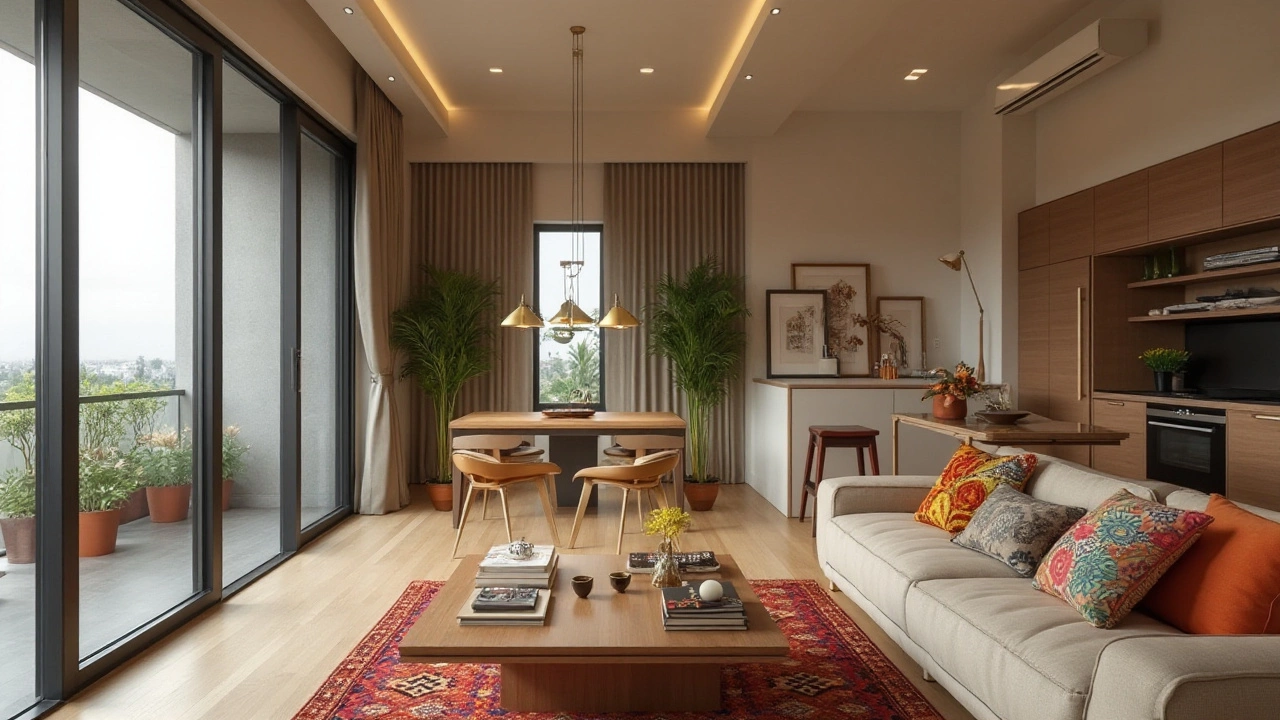A 900 sq ft house may not seem excessively spacious, yet it harbors the potential for a comfortable life. This size typically accommodates a 2BHK apartment, offering a practical solution for families, couples, or individuals who prize efficiency. While these homes are petite, their charm lies in their simplicity and ease of management.
They encourage you to reconsider your possessions, focus on what truly matters, and explore innovative design techniques to craft a vibrant living space. For those intrigued by compact dimensions or looking to save on expenses and environmental cost, understanding how to utilize this space can be rewarding. Dive in to discover how to transform 900 square feet into an inviting haven.
- Understanding the Dimensions
- Space Utilization Tips
- Advantages of Compact Living
- Design Ideas for 2BHKs
- Economic and Eco-Friendly Aspects
- Choosing the Right Location
Understanding the Dimensions
A 900 sq ft house is designed to offer a balance between functionality and simplicity. Picture it as a large square with each side measuring around 30 feet, although often, it's more rectangular than square. Within this structure, the magic unfolds with a clever division of space that accommodates two bedrooms, a kitchen, and sometimes a living area. But what does this mean for your day-to-day life? With an average bedroom size squeezing into roughly 130-150 square feet, you’re looking at comfortably fitting in a queen-size bed with some room for a wardrobe and bedside tables. The beauty of a 2BHK apartment lies in its compactness, challenging you to creatively utilize every available inch.
When it comes to the layout, these apartments embrace an open-plan design concept. This knocks down unnecessary walls, allowing the living room to flow seamlessly into the kitchen or dining space, fostering a sense of openness even within a limited area. This connectivity not only maximizes light filtering through the apartment but also brings about a sense of inclusivity, something vital in small family units or for social gatherings. As we embrace living with less space, it becomes pivotal to be selective about what finds its way within these walls, favoring multi-functional furniture and creative storage solutions. A quote from renowned architect Ludwig Mies van der Rohe might resonate here, "Less is more."
Let’s not forget, the size of 900 square feet can vary significantly in experience based on its structural features. High ceilings, for example, can dramatically enhance the feel of a space, creating an illusion of grandeur. Similarly, large windows invite more natural light, making rooms look larger and more inviting. It’s fascinating how subtle architectural tweaks can shift perceptions and utility within the same amount of physical space. To further illustrate this, consider how the inclusion of a mezzanine or a loft could transform one of the bedrooms into a home office, offering additional utility without expanding the footprint.
Consider this: deploying folding or extendable furniture in these homes is a smart strategy. For instance, wall-beds that tuck away or dining tables that double as workstations ensure you're not sacrificing comfort for space. An understanding of dimensions also involves recognizing how essentials like kitchen counters and bathroom fittings should be right-sized to balance usability and aesthetics. Inviting a minimalist mindset to design helps in embracing fewer, well-chosen furnishings that serve multiple functions and increase the overall appeal of the home. Such innovative solutions are strategies we ought to explore.
A look at prestigious interior design magazines shows that even luxury brands are now creating lines specifically tailored for compact living spaces, acknowledging a shift in how we perceive luxury—it’s now less about grandeur and more about intelligent design. Take a peek at how Scandinavian interiors, popular for their elegance and simplicity, seamlessly integrate into smaller spaces worldwide. This global trend hints at a broader movement towards valuing environment over excess, an idea even small spaces heartily endorse.
Understanding these dimensions does not merely endow one with appreciation; it inspires ideas about lifestyle choices and environmental impacts. Homes of this size naturally curb needless excess, often leading to a greener footprint. In a world where urban density is rising, and natural resources are depleting, this style of housing becomes not just practical, but morally aligned with a more sustainable future. As we step into this realm of compact living spaces, it’s a gateway to thriving creatively within our means, focusing on quality over quantity, and ensuring that each square foot contributes meaningfully to our living experience.
Space Utilization Tips
When it comes to making the most of a 900 sq ft house, creativity and planning are key. This space, often configured as a 2BHK apartment, invites you to reimagine room usage and prioritize what truly enhances your living experience. One effective approach to maximizing your living space is through the strategic use of furniture. Opt for furniture pieces that serve multiple functions, such as a sofa bed or a foldable dining table. This not only saves space but also adapts to varied needs, whether you're hosting a dinner or accommodating overnight guests. Another clever trick is to go vertical. Utilizing the height of a room can dramatically expand your storage capabilities. Think tall shelves or kitchen cabinets that reach up to the ceiling. It's remarkable how much additional space you can discover if you just look upwards.
Decluttering is an essential part of creating a spacious feel in a 900 sq ft apartment. Marie Kondo, a renowned productivity expert, emphasizes, "The best way to find out what we really need is to get rid of what we don't." This philosophy not only reduces clutter but also helps you live a minimalist lifestyle that celebrates essentialism. Additionally, embracing open-plan living can have a substantial impact. Knocking down non-structural walls that separate the kitchen from the living area can make your home feel more expansive. With the use of light colors on walls and floors, you can further enhance an airy feeling. Mirrors, strategically placed across from windows, can also reflect light and give an illusion of depth.
Smart storage solutions are indispensable in a smaller living area. Invest in under-bed storage or ottomans that double as storage units. It’s about combining aesthetic appeal with functionality. Another practical tip is identifying underutilized spaces like the area underneath the staircase or awkward corners, which can be transformed into cozy reading nooks or additional storage. When it comes to the kitchen in a 2BHK apartment, using hooks and magnetic strips can free up counter space by keeping utensils and spices off surfaces. It's fascinating how these small adjustments can lead to a large impact on overall living comfort.
"Designing your space thoughtfully means instantly expanding it, without adding a square inch," says interior architect Ilse Crawford.
Lighting also plays a crucial role in space perception. Natural light opens up a room and makes it warmer and more inviting. If extensive natural light is challenging to come by, strategically placed lamps, such as uplighters, can add a sense of height and spaciousness. Task lighting, on the other hand, ensures that each functional space—like your kitchen counter or office nook—is adequately lit, keeping it welcoming and usable. Implementing technology, like smart home devices, can help manage how space is used throughout the day and even monitor energy efficiency.
By incorporating these tips and strategies, you can transform a compact living area into a home that feels more spacious and functional. It encourages thoughtful lifestyle choices that lead to efficient use of resources and improved quality of life, without sacrificing comfort or elegance. Is it any wonder that living well in a 900 sq ft home is as much about resourcefulness as it is about the space itself?

Advantages of Compact Living
Living in a 900 sq ft house presents a wealth of benefits that stretch beyond the immediate constraints of square footage. One of the primary advantages lies in the way these spaces encourage us to declutter our lives, focusing only on what is truly necessary. This shift towards minimalism can lead not only to a clearer physical space but also to a clearer mental headspace, as we are no longer overwhelmed by an excess of belongings. Compact homes often require less maintenance, too. With fewer rooms and surfaces to clean, those precious weekend hours can be reclaimed for relaxing, hobbies, or spending time with family and friends.
The financial aspect of compact living cannot be overlooked either. Smaller homes typically mean lower utility bills, as there is less space to heat or cool. This economic benefit extends to the actual cost of the property, as prices often correlate with size. A smaller footprint often equates to a more affordable mortgage without the compromise of residing in excellent neighborhoods, allowing more first-time buyers to step onto the property ladder. Additionally, with the planet's resources under strain, opting for a smaller dwelling can contribute positively to reducing one's environmental footprint through lower energy usage and reduced construction materials.
Mobility and Versatility
Another interesting factor is the increased mobility that can come with living in a 2BHK apartment of such size. Without the burden of excess possessions, individuals and families find it easier to relocate if their circumstances change. This can be particularly beneficial for those whose work requires frequent moves or for those who crave fresh starts in new locations regularly. Importantly, the compact living lifestyle renders these transitions less taxing, both financially and emotionally. Quoting renowned architect Sarah Susanka, who has championed 'the not so big house' movement,
“Our houses are too big for our own good, and they do not well serve our lives.”This perspective has sparked a wider acceptance of smaller yet thoughtfully-designed living spaces.
A unique feature of compact living is its inherent demand for innovative use of space, sparking creativity in interior design. Homeowners and tenants often employ multipurpose furniture, clever storage solutions, and transformative layouts to make the most out of limited spaces. This necessity to innovate often leads to highly personalized and efficient living environments that are tailored to the occupants' lifestyle in ways larger homes might not achieve. Coupled with the benefits of reduced environmental impact and cost savings, 900 square feet of living space can offer a rewarding and fulfilling home environment.
Design Ideas for 2BHKs
Living in a 900 sq ft house brings the challenge and joy of making every inch count in a 2BHK apartment. To start, embracing an open floor plan can significantly enhance the sense of space. By minimizing walls and barriers, you allow light and air to flow freely, creating a welcoming and expansive atmosphere. Consider leveraging multi-functional furniture, such as a sofa bed or an extendable dining table, which can transform the same area for different purposes throughout the day. Wall-mounted shelves are your best friend in these settings, adding storage without eating up floor space. Integrating mirrors can also work wonders, reflecting light and giving the illusion of a larger area. A strategic placement of these elements can transform a compact home into a surprisingly ample-looking haven.
Another innovative design approach involves technology. With smart home solutions, spaces can adapt to the needs of the occupants. Consider installing programmable lighting and climate control systems to ensure energy efficiency — a notable perk for eco-conscious individuals. Incorporating sliding or folding doors instead of traditional swing doors is a clever trick that saves space. In places like the kitchen, overhead cabinets can declutter countertops, providing just the right amount of storage without overwhelming the area with furniture. Colors, too, play a vital role, and a palette of soft, light hues can add to the spacious feel. Adding bold accents can create focal points, drawing attention and adding personality without cluttering.
It’s fascinating how certain design principles help maximize small living space. One valuable tip is engaging vertical spaces. In many instances, ceilings are underused, but by installing tall bookshelves or hanging plants, you draw eyes upwards, giving an impression of spaciousness. Textile choices such as light, breezy curtains enhance the fluid feel, while lush rugs can define different zones without erecting physical barriers. Don’t forget your outdoor corridors, balconies, or patios — even if small, they extend living areas and present unique opportunities for creativity. Designing such spaces with folding chairs, small tables, and lots of green can make quaint retreats where you can unwind.
"The secret of getting ahead is getting started," said the iconic author Mark Twain. Indeed, beginning your design journey with a concrete plan is key.Organize your ideas and mood boards, envision how each room will fulfill its intended function, and progress from there. You might want to opt for a minimalist style that naturally complements smaller spaces. When every item is chosen with thought, based on necessity and aesthetics, what evolves is a naturally coherent and uncluttered living environment. Making deliberate design decisions fosters not only a visually appealing home but also one that feels anchored and peaceful.
Lastly, personalization should not be overlooked — it turns a house into a home. Displaying artworks that resonate with you, arranging personal memorabilia, or crafting DIY decor pieces add intimacy and warmth beyond mere design. The apartment size should never limit your creative vision; rather, it should challenge you to approach it with ingenuity and imagination. With the right strategies and mindset, a 900 sq ft home can overflow with character and function, presenting a living experience that is both enriching and fulfilling.

Economic and Eco-Friendly Aspects
Living in a 900 sq ft house is not just about embracing a cozy lifestyle; it appeals to those keen on saving financially and reducing their carbon footprint too. Economically, these apartments present several advantages, from lower purchase costs to reduced expenses related to utilities and maintenance. A compact living space demands that fewer resources be devoted to heating, cooling, and cleaning, which often leads to significant savings over time. Many find that these financial benefits make 2BHK apartments an appealing option, especially when entering the competitive real estate market.
From an eco-friendly perspective, small homes like 2BHKs encourage sustainable living by design. They inherently require fewer materials to build and less land, preserving the natural habitat. Without the need for excessive building resources and energy consumption, they serve as a stepping stone toward a greener Earth. Those who inhabit such spaces often develop habits of conscious consumption and simpler living, opting for energy-efficient appliances and low-waste lifestyles. It's remarkable how such a lifestyle change, though initially driven by limited space, morphs into a commitment to conservation and an appreciation for sustainable practices.
The ecological footprint of a smaller home can be delightfully minimal. As urban areas continue to grow, these apartment sizes are a gift to the densely populated spaces struggling with sustainability issues. They promote urban densification, which means reduced urban sprawl and less pressure on public services and infrastructure. According to a study by the National Association of Home Builders, homes constructed in recent times have seen a trend of decreasing size, reflecting a growing awareness of environmental impacts. These factors indeed make a strong case for those considering a shift to smaller homes.
"The momentum towards intentional living in smaller spaces is not just a personal choice, but a necessary shift in our collective conscience," says renowned architect Sarah Susanka, famed for her advocacy of 'The Not So Big House' philosophy.
The economic and eco-friendly benefits enjoyed within a 900 sq ft apartment are deeply intertwined. When people choose such homes, they inadvertently support a movement towards conscious living. The combined effect of these benefits allows residents to feel a sense of connectedness to the wider environmental and economic narratives that shape our planet's health. Ultimately, by valuing simplicity and sustainability, residents of these compact homes are leading crucial change, one square foot at a time.
Choosing the Right Location
Deciding on the right location for a 900 sq ft house is just as crucial as maximizing its interior space. When you're living in a compact area, the location surrounding it becomes an extension of your home. One of the first things to ponder is the commute to work or school, because no matter how perfect the interior design, a lengthy commute can diminish the quality of daily life. Additionally, consider the accessibility of public transportation, as convenience plays a vital role for those intending to manage without a vehicle. This practical aspect could significantly affect personal schedules and life satisfaction.
The neighborhood's safety is another essential factor. Investigate the area’s crime rate, and speak with local residents to get an honest take on the community’s security. An inviting neighborhood, where residents watch out for each other, contributes to personal peace of mind. Schools often play a big role, especially for families with children. It's wise to check if there are well-regarded schools within a reasonable distance. Real estate experts frequently emphasize that buying a home is as much about the location as it is about the house itself. As Barbara Corcoran once noted,
"A funny thing happens in real estate. When it comes back, it comes back up like gangbusters.”Understanding that school districts can influence property values is important, whether you plan to sell your home in the future or wish to maintain its value.
Access to amenities such as parks, grocery stores, and health care facilities also factors into the decision-making process. Urban areas may offer more in terms of convenience and entertainment options, but they might come with steeper costs or a more hectic pace. Conversely, suburban or rural settings might promise tranquility and lower living costs, but could lack certain conveniences. The climate of the area can also impact your choice. Some climates are more conducive to outdoor activities, which can mitigate the compactness of a 2BHK apartment by providing ample outdoor spaces to explore. If sustainability is a concern, evaluate the area's environmental policies or initiatives. Living in a community that prioritizes green spaces or has efficient waste management systems can enhance your quality of life, aligning with eco-friendly living in a smaller footprint.
Ultimately, weighing the proximity to family and friends should not be underestimated. Humans are social creatures, and having a support network nearby can be invaluable, bringing immeasurable benefits to life quality. While a 2BHK apartment in a small living space might limit what's within your walls, choosing the right location empowers you to expand your life beyond them, creating a harmonious balance that complements your lifestyle.

